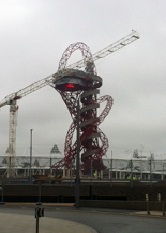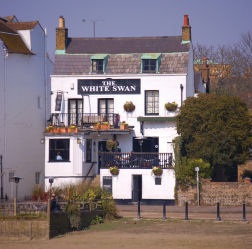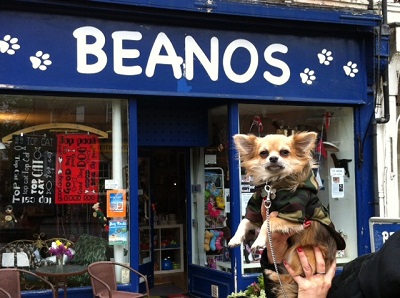
A former work colleague qualified as a London Blue Badge tourist guide and I had heard that he ran a two hour walk around the Olympic Village in East London. As I hadn’t yet got the Olympic bug – and my tickets are for taekwondo at ExCeL – I thought a bracing walk around the area might be good exercise for Alfie and I, so we signed up.
Bromley-by-Bow
Like most days at the moment, it was raining heavily as I made my way from Twickenham in West London over to Bromley-by-Bow – taking an unusual route via Vauxhall and Victoria in view of the Sunday engineering works.
There were a fair few Blue Badge folk – and their walkers – gathered at the tube station but our smaller group of 10 (obviously the rain proved a deterrent for some) introduced ourselves before setting off into the heavy rain. I quickly started chatting to the owner of a retriever and a Cocker Spaniel.
We walked past some rather derelict buildings to reach a large Tesco store where we made an early toilet stop and stocked up on water and all manner of chocolaty things to sustain us for our journey.
Lee River and Three Mills
Within moments we were surrounded by water – not just from the sky but from two large canals. We took shelter under a couple of trees while Mark told us about the three impressive buildings in front of us.
The oldest water mill in the UK (built 1776) was important in the area’s history and its role in baking – courtesy of the river ways being the chief method of conveying agricultural goods from Anglia and up the Thames. Apparently it is being converted to a hydro power facility. We also learned a little about the area’s ship building past.
There was also a delightful clock mill complete with two oast house towers. Just around the corner was Studio Mill which is where numerous recent films and television programmes have been made – and where, we were told, the rehearsals for the Olympic opening ceremony take place (it’s called “the Isle of Wonder” and is based loosely on Shakespeare’s Tempest).
Mark also explained that Bromley-by-Bow is so named after a wooden bow-shaped bridge that was built after a queen took a tumble on her journey along the Roman road to Colchester – where the Romans settled when they first came to Britain. OK, history’s not my strong point and it was hard paying attention in the driving rain. It was none too warm either. (Apologies Mark if I misrepresented your explanation but note taking wasn’t possible!)
Regeneration
Not surprisingly, the area is called Three Mills and we wandered over to some lovely grassy open areas – again, alongside canals - where there were numerous happy dogs and their owners playing about completely oblivious to the weather.
The strangely named “Fat Path” starts here – and apparently there are hundreds of pathways all around the area that have recently been created as part of the regeneration. There’s also a statue of some hands marking the spot where five workers died in an industrial accident.
On one side we saw an area that Ikea (yes, the furniture people) were turning into sustainable homes – with a good proportion for key workers and social housing - and on the other side we could see the distant red tower that was the pumping station for London’s original sewers.
Whilst we continued walking along the canal, admiring the brightly covered house boats, we learned more about the Olympic development. It covers 500 acres (that’s bigger than Monaco) and much of the £9.2 billion investment will remain in use for the legacy which includes the biggest park in Europe when the Olympics are done.
Pointing out old sugar factories we were told that the area had been given the postcode of E20 and this one of the four new areas was called Sweet Water. Here we stopped to admire a brand new wooden sculpture in the shape of the Olympic flame – the design of which has already won numerous awards.
Peripheral roads, new housing and the Orbit sculpture
We left the tranquillity of the canal ways and walked along a road for a little while and then rested under a temporary bridge which people from the coach parks will use. Mark pointed out some of the key businesses (including one of the only fish smoking plants) amongst the 200 that were subject to compulsory purchase to make way for all the development.
There was a listed building here with a painting of a girl gathering lavender – the home of Yardley toiletries and a reminder of another part of the area’s past. There were lots of brand new brightly coloured blocks of residential apartments. We crossed a few roads and admired a particularly fine multi-coloured private residential development called Icona.
We had reached the main perimeter fence and caught our first glance of the village – the bright red twisted rings sculpture by Anish Kapoor. 80% of the cost of the Orbit sculpture, which at 114.5 metres is the largest sculpture in the UK, was provided by steel magnets at ArcelorMittal. I made a secret resolution that I would one day go up to the viewing platform at the top.
From this point we could see one of the security check points – with the sniffer dogs going about their work with a spring in their step and a wag of their tails – and some of the railways. Apparently, Stratford is now the second largest transport hub after Kings Cross.
Artwork and sustainability
Near a roundabout we were greeted by the site of a huge artwork that hides the enormous tunnels carrying all the cables. Mark told us that when they started building on the site they took all the soil to a “soil hospital” so that all of the chemicals and contaminates (including Japanese Knotweed) were removed. Also that 90% of the construction materials used were from buildings that were in the area – so those walls really do contain a lot of history.
He got a big technical when he started explaining that the area generated its own power through biomass generators. I was still staring at the red Orbit sculpture…
Olympic Stadium and the Aquatics Centre
Whilst we couldn’t get close, it was exciting to see the 80,000 capacity stadium which Mark explained was collapsible. He gave us a quick update on the various negotiations between football clubs (West Ham and Tottenham Hotspurs) for the facility – with or without the athletics track - post-games. We also found out that McDonalds – which will be the only branded food at the games (can’t imagine that the athletes will eat it!) - plans its largest ever outlet there on a temporary basis.
There was a fabulous view of the Aquatics Centre – which has also won awards – and it’s two temporary “wings” to provide additional seating. It looks stunning. Even in the pouring rain surrounded by work men.
Stratford Westfield and the John Lewis viewing area
At this point we had reached Westfield – which I have visited previously. The Australian developers committed to the area before London had won the bid – and the 280 shops and 70 eating establishments make it the largest City based shopping centre in Europe.
Interestingly, Mark told us that the Westfield in Shepherd’s Bush is on the site from the previous London Olympics (couldn’t remember whether it was the 1908 games displaced from Rome due to the volcanic eruption or the 1948 austerity games).
It was a relief to get out of the rain and Mark led us to the third floor of John Lewis where there is a large Olympic shop and a huge area with panoramic views over the Olympic Village site. It really was one of the best ways to see the sheer scale of the development. Mark carried on explaining some of the key buildings – including the low level water polo building and the distant “copper box” which will be where the handball, goalball (for visually impaired people where the ball contains a bell) and the fencing discipline of Modern Pentathlon. (Remember that dogs aren’t allowed in John Lewis!)
It was great to spend a couple of hours learning about the area and seeing all the amazing work and regeneration. Mind you, you don’t have to wait for a guided tour – take a tube out there and walk around. Loads of space, lots to see and so many great walks along canals and waterways.
All Mark’s walks are listed here: http://www.secret-london.co.uk/Walks_Mark_King.html and there is an email list where you can sign up for details of future walks.


